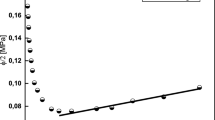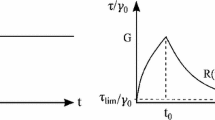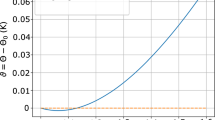Abstract
In this research, the hyperelastic strain energy density function based on the exponential–logarithmic invariant is extended to the visco-hyperelastic constitutive model to describe the mechanical characteristics of the rate dependence and large deformations of rubber-like materials. On the basis of the general regression neural network (GRNN) technique, a parameter identification approach for the visco-hyperelastic model is designed. In addition, the proposed research scheme is verified using various uniaxial experimental data of rubber-like materials. The comparison results reveal that the predicted stress responses agree well with the experimental data under different loading conditions. This paper concludes that the present model can describe the mechanical behavior of rubber-like materials and that the GRNN-based approach is practicable for parameter identification of complex visco-hyperelastic constitutive models.







Similar content being viewed by others
References
Arlot, S., Celisse, A.: A survey of cross-validation procedures for model selection. Stat. Surv. 4, 40–79 (2010)
Bazkiaei, A.K., Shirazi, K.H., Shishesaz, M.: A framework for model base hyper-elastic material simulation. J. Rubber Res. 23(4), 287–299 (2020)
Beda, T.: An approach for hyperelastic model-building and parameters estimation a review of constitutive models. Eur. Polym. J. 50, 97–108 (2014)
Brinson, H.F., Brinson, L.C.: Polymer Engineering Science and Viscoelasticity: An Introduction. Springer, Cham (2015)
Carpi, F., De Rossi, D., Kornbluh, R., et al.: Dielectric Elastomers as Electromechanical Transducers: Fundamentals, Materials, Devices, Models and Applications of an Emerging Electroactive Polymer Technology. Elsevier, Amsterdam (2011)
Carpi, F., Anderson, I., Bauer, S., et al.: Standards for dielectric elastomer transducers. Smart Mater. Struct. 24(10), 105025 (2015)
Darijani, H., Naghdabadi, R.: Hyperelastic materials behavior modeling using consistent strain energy density functions. Acta Mech. 213(3), 235–254 (2010)
Elyasi, N., Taheri, K.K., Narooei, K., et al.: A study of hyperelastic models for predicting the mechanical behavior of extensor apparatus. Biomech. Model. Mechanobiol. 16(3), 1077–1093 (2017)
Fatt, M.S.H., Ouyang, X.: Integral-based constitutive equation for rubber at high strain rates. Int. J. Solids Struct. 44(20), 6491–6506 (2007)
Gent, A.N.: A new constitutive relation for rubber. Rubber Chem. Technol. 69(1), 59–61 (1996)
Goh, S., Charalambides, M., Williams, J.: Determination of the constitutive constants of non-linear viscoelastic materials. Mech. Time-Depend. Mater. 8(3), 255–268 (2004)
Hou, J., Lu, X., Zhang, K., et al.: Parameters identification of rubber-like hyperelastic material based on general regression neural network. Materials 15(11), 3776 (2022)
Im, S., Kim, W., Kim, H., et al.: Artificial neural network modeling of anisotropic hyperelastic materials based on computational crystal structure data. In: AIAA Scitech 2020 Forum, p. 0397 (2020)
Khajehsaeid, H., Arghavani, J., Naghdabadi, R.: A hyperelastic constitutive model for rubber-like materials. Eur. J. Mech. A/Solids 38, 144–151 (2013)
Khajehsaeid, H., Arghavani, J., Naghdabadi, R., et al.: A visco-hyperelastic constitutive model for rubber-like materials: a rate-dependent relaxation time scheme. Int. J. Eng. Sci. 79, 44–58 (2014)
Kim, D.H., Ghaffari, R., Lu, N., et al.: Flexible and stretchable electronics for biointegrated devices. Annu. Rev. Biomed. Eng. 14(1), 113–128 (2012)
Li, C., Lua, J.: A hyper-viscoelastic constitutive model for polyurea. Mater. Lett. 63(11), 877–880 (2009)
Li, T., Keplinger, C., Baumgartner, R., et al.: Giant voltage-induced deformation in dielectric elastomers near the verge of snap-through instability. J. Mech. Phys. Solids 61(2), 611–628 (2013)
Li, T., Zou, Z., Mao, G., et al.: Agile and resilient insect-scale robot. Soft Rob. 6(1), 133–141 (2019)
Li, Y., Sang, J., Wei, X., et al.: Inverse identification of hyperelastic constitutive parameters of skeletal muscles via optimization of AI techniques. Comput. Methods Biomech. Biomed. Eng. 24(15), 1647–1659 (2021)
Lion, A.: A constitutive model for carbon black filled rubber: experimental investigations and mathematical representation. Contin. Mech. Thermodyn. 8(3), 153–169 (1996)
Mansouri, M., Darijani, H.: Constitutive modeling of isotropic hyperelastic materials in an exponential framework using a self-contained approach. Int. J. Solids Struct. 51(25–26), 4316–4326 (2014)
Mao, G., Huang, X., Liu, J., et al.: Dielectric elastomer peristaltic pump module with finite deformation. Smart Mater. Struct. 24(7), 075026 (2015)
Martins, P., Natal Jorge, R., Ferreira, A.: A comparative study of several material models for prediction of hyperelastic properties: application to silicone-rubber and soft tissues. Strain 42(3), 135–147 (2006)
Matin, Z., Moghimi Zand, M., Salmani Tehrani, M., et al.: A visco-hyperelastic constitutive model of short-and long-term viscous effects on isotropic soft tissues. Proc. Inst. Mech. Eng. C J. Mech. Eng. Sci. 234(1), 3–17 (2020)
Mooney, M.: A theory of large elastic deformation. J. Appl. Phys. 11(9), 582–592 (1940)
Narooei, K., Arman, M.: Generalization of exponential based hyperelastic to hyper-viscoelastic model for investigation of mechanical behavior of rate dependent materials. J. Mech. Behav. Biomed. Mater. 79, 104–113 (2018)
Ogden, R.W.: Non-linear Elastic Deformations. Courier Corporation, Chelmsford (1997)
Ogden, R.W., Saccomandi, G., Sgura, I.: Fitting hyperelastic models to experimental data. Comput. Mech. 34(6), 484–502 (2004)
Patra, K., Sahu, R.K.: A visco-hyperelastic approach to modelling rate-dependent large deformation of a dielectric acrylic elastomer. Int. J. Mech. Mater. Des. 11(1), 79–90 (2015)
Rivlin, R.S., Thomas, A.: Large elastic deformations of isotropic materials viii. Strain distribution around a hole in a sheet. Philos. Trans. R. Soc. Lond. Ser. A Math. Phys. Sci. 243(865), 289–298 (1951)
Rooki, R.: Application of general regression neural network (GRNN) for indirect measuring pressure loss of Herschel–Bulkley drilling fluids in oil drilling. Measurement 85, 184–191 (2016)
Specht, D.F., et al.: A general regression neural network. IEEE Trans. Neural Netw. 2(6), 568–576 (1991)
Steinmann, P., Hossain, M., Possart, G.: Hyperelastic models for rubber-like materials: consistent tangent operators and suitability for Treloar’s data. Arch. Appl. Mech. 82(9), 1183–1217 (2012)
Sunderland, P., Yu, W., Månson, J.A.: A thermoviscoelastic analysis of process-induced internal stresses in thermoplastic matrix composites. Polym. Compos. 22(5), 579–592 (2001)
Talebi, S., Darijani, H.: A pseudo-strain energy density function for mechanical behavior modeling of visco-hyperelastic materials. Int. J. Mech. Sci. 208(106), 652 (2021)
Taylor, R.L., Pister, K.S., Goudreau, G.L.: Thermomechanical analysis of viscoelastic solids. Int. J. Numer. Methods Eng. 2(1), 45–59 (1970)
Treloar, L.G.: The Physics of Rubber Elasticity. Oxford University Press, Oxford (1975)
Xiang, Y., Zhong, D., Wang, P., et al.: A physically based visco-hyperelastic constitutive model for soft materials. J. Mech. Phys. Solids 128, 208–218 (2019)
Yeoh, O.H.: Some forms of the strain energy function for rubber. Rubber Chem. Technol. 66(5), 754–771 (1993)
Acknowledgements
This work was supported by the National Natural Science Foundation of China (No. 12172270), the Qin Chuangyuan “Scientists+Engineers” Team Construction Project in Shaanxi Province (2022KXJ-085), and the Fundamental Research Funds for the Central Universities in China, the Application Innovation Program of China Aerospace Science and Technology Corporation (No. 6230112002) and the Basic Research Priorities Program from Equipment Development Department of China (No. 514010304-302-2).
Author information
Authors and Affiliations
Corresponding author
Ethics declarations
Conflict of interest
On behalf of all authors, the corresponding author states that there is no conflict of interest.
Additional information
Publisher's Note
Springer Nature remains neutral with regard to jurisdictional claims in published maps and institutional affiliations.
Rights and permissions
Springer Nature or its licensor (e.g. a society or other partner) holds exclusive rights to this article under a publishing agreement with the author(s) or other rightsholder(s); author self-archiving of the accepted manuscript version of this article is solely governed by the terms of such publishing agreement and applicable law.
About this article
Cite this article
Chen, S., Wang, C., Lu, X. et al. A parameter identification scheme of the visco-hyperelastic constitutive model of rubber-like materials based on general regression neural network. Arch Appl Mech 93, 3229–3241 (2023). https://doi.org/10.1007/s00419-023-02434-z
Received:
Accepted:
Published:
Issue Date:
DOI: https://doi.org/10.1007/s00419-023-02434-z




